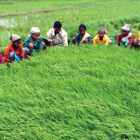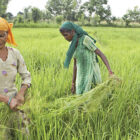The crisis engulfing farmers was created by negligence and bad policy. The resultant migration to urban India has devastating socio-economic consequences.
Never before in Indian history have the landless seemed to be better off than marginal and small land-owning farmers. Emotionally attached to their lands, small farmers continue to try, unsuccessfully, to make a living from their meagre holdings while those with no land have little to hold them back from moving to other professions or migrating in the hope of better opportunities.
Pent-up frustration has erupted in more farmer agitations across India in the past four years than in the preceding decades. The current times are reminiscent of those when Mahatma Gandhi returned from South Africa in 1916 to launch the Champaran Satyagraha. Along with the Kheda Satyagraha in Gujarat, such farmers’ uprisings got channelised into the grassroots of the Indian Independ-ence movement. The current turmoil may well signify the beginning of yet an-other momentous change.
Prime Minister Narendra Modi’s larger-than-life image, emphasised by clever marketing, sloganeering, social media and advertising, had raised the hopes of millions in rural India. Having won an unexpectedly massive mandate, he start-ed off with a huge advantage over the government that his dispensation replaced. Though he had inherited a declining farm economy, he was blessed with very low petroleum prices that led to several lakh crores of savings accruing to the exchequer and the nation too was ready to believe and follow the new leader, even on the path of thorns that he set.
Not since Indira Gandhi has India had a prime minister as bold and authorita-tive as Narendra Modi. The former helped to create Bangladesh out of East Pa-kistan, nationalised private banks, ended the privy purses but also imposed the Emergency. Modi announced demonetisation that took 80 per cent of the cash out of circulation in the beginning of the sowing season and followed up with a poorly implemented GST. The double whammy, entirely human induced, ac-companied the twin mammoth shocks of a back-to-back drought and very low international commodity prices.
This vicious concoction destroyed the hopes of millions and dented Modi’s in-fallible image. The two-year drought led to a production shortfall and high commodity prices. When farmers responded to market signals of high prices of pulses and oilseeds, production jumped up, while the country kept importing pulses and edible oil at zero import duty. It took the combined force of cabinet minister Nitin Gadkari, CEA to PM, Arvind Subramanian, and Niti Aayog member, Ramesh Chand, to coerce the establishment to stop import of pulses and to take other remedial measures. These came too late as large segments in the countryside went over the edge.
Several central farm schemes did not deliver. Commodity prices fell, input pric-es shot up, thus decimating farmer incomes. Trying to salvage the situation after the Mandsaur calamity, the Nashik-Mumbai march and other agitations, the gov-ernment panicked, over-reacted and committed a bigger political blunder by an-nouncing higher minimum support prices (MSPs). The methodology to calcu-late the MSP was contentious but even that would not have become an issue had farmers been able to sell their crops at the promised price. Unfortunately, nei-ther this nor the next government can purchase all the crop production for which MSPs are announced.
The PM seems to have been isolated from the cacophony of discontent by a party leadership fearful of speaking the truth. More importantly, an incompetent opposition seems to have given a high dose of dopamine that kept it out of touch with ground realities. Wary of inflation that had battered UPA-II and pro-pelled the BJP to power in 2014, the government prioritised keeping inflation low for consumers and, by design, farmers became the primary inflation mitiga-tion tool and scapegoats.
The Pradhan Mantri Fasal Bima Yojana, electronic trading portal e-Nam, soil health cards, model APLM act 2017 and a slew of other schemes have failed to deliver. Falling commodity prices fell and expensive agriculture inputs decimat-ed farmer incomes. Doubling farm incomes has become a dark and cruel joke. The National Forest Policy 2018 has been a dampener for tribal farmer rights and those living on the margins. Consequently, the largest silent migration in human history is underway; from rural to urban areas with severe socio-economic consequences.
While the government wisely retreated from its stated position by continuing with the MGNREGA, it was forced to abort the land acquisition bill. Govern-ment actions have also had unintended positive consequences, like reducing urea bag size from 50 kg to 45 kg has reduced per acre consumption by 10 per cent, because the farmer measures the input by the bag, not the weight. The de-partment, however, deludes itself by believing that it is the introduction of the neem coating to urea that has led to the improvement.
Agriculture is a state subject; when states are not able to perform, the centre too gets the blame. It is equally true that policies for farmers are made by the central government without consulting states or even the beneficiaries, the farmers. Therefore, central policies look good on paper but cannot be implemented; there is a basic design flaw as policy-makers lack the capacity to make informed choices. In days to come, the signing of the international trade treaty, the Regional Comprehensive Economic Partnership, without consulting the states and farmer interests will add to the trauma of the community.
The 14th Finance Commission has seen a 42 per cent fund devolution to the states and it would be unfair to blame Narendra Modi for reduced allocations for agriculture programmes. The state governments are supposed to utilise the increased resource allocations as they prioritise their agriculture needs, which they do not. Accepting the 7th Pay Commission recommendations was, howev-er, a gigantic blunder. It strained central government finances and even the states will be compelled to accept it. After salaries and pensions have been paid, the states will have no spare resources for development or for even tapping into cen-tral government programs like RKVY and ATMA, which require sharing of costs.
For all his well-intentioned plans to improve farmer livelihoods, the failure may well be attributed to over-reliance on the bureaucracy. Even as farmer suicides take place without let or hindrance, the government is hiding the figures. Bro-ken promises like the Rs 15 lakh in bank accounts is not what haunts the BJP the most though. The unkept promise of providing two crore off-farm jobs and lack of livelihood prospects for farmers’ children is the gravest let-down. Over the decades, the ruling party has honed tactics to blame states for most problems. With the BJP ruling at the centre and in the states, this is no longer an excuse.
Taking for granted disunited farmers and making the blunder of believing them to be of little electoral significance may prove costly for more reasons than one. If the Congress makes substantial gains in the state elections, an all-India farm loan waiver may well be on the cards, because there is nothing left to promise or deliver. The future is frightening in terms of the total vacuum of farmer leader-ship within the top hierarchy of all large political parties today.




